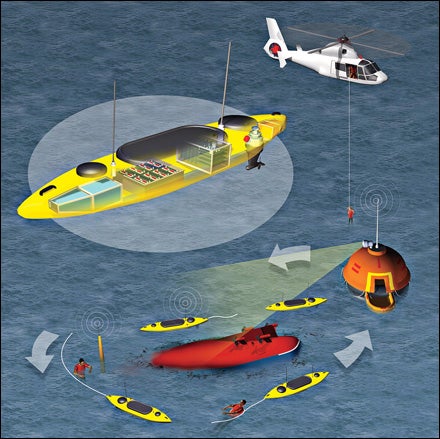WHEN THE 44-FOOT luxury ocean catamaran Cat Shot capsized in 30-foot seas off Oregon’s Cape Blanco in December, the three crew members didn’t even have a chance to activate the ship’s EPIRB (emergency position-indicating radio beacon), which would have alerted rescuers. All three men were lost. But in the near future, sailors in similar situations may be able to rely on autonomous onboard robots to send distress calls and, if necessary, locate survivorsboth conscious and unconsciousand keep them safe until help arrives. At MIT’s Center for Ocean Engineering, researchers have developed prototype kayak-based robots called SCOUTs (surface crafts for oceanographic and undersea testing) that could change the face of marine rescue. Here’s how they’ll work.
Three More Robotic First Responders
1. NighthawkWhat: An aerial robot equipped with thermal- and visual-imaging tools that can detect people in snow or help firefighters find escape routes through blazes. Fits in a backpack and launches by hand. Developer: Applied Research Associates Inc., Albuquerque, New Mexico In Use: Now
2. Souryu
What: A snakelike robot that can crawl through small, treacherous spaces to search for people buried in earthquake rubble. A camera and microphone transmit signals back to an operator. Developer: Tokyo Institute of Technology In Use: 2009
3. Capuchin
What: A four-legged climbing robot that can be used for rescue…
ON CALL The mostly inflatable SCOUT system self-launches when a ship is sinking or when a crew member activates it manually. It could also be deployable by air. The size and number of units will depend on the size of the ship.
MISSION CONTROL The motorized(1) SCOUT kayaks will communicate via a local (2) Wi-Fi network and GPS transmitters, coordinating to find victims as quickly as possible. Ideally, everyone on board will wear a radio-frequency identification (RFID) tag to help the SCOUTs locate them. (3) Biometric heat and motion sensors help identify unconscious victims so that the SCOUTs can prioritize their efforts.
PERSONAL FLOTATION The crafts encircle victims with (4) coiled hoses that detach in airtight sections and self-inflate to create emergency PFDs. Each segment will also have an (5) inflatable beacon with superbright LED strobes (visible for miles), a lift hook for rescue helicopters, and an individual GPS transmitter.
SURVIVAL ISLAND Based on existing 12-to 15-person life rafts, these (6) inflatables will be outfitted with gyroscopic spotlights for aiding swimmers and rescuers, an emergency radio, and an EPIRB for broadcasting latitude and longitude coordinates to rescue teams. Onboard microprocessors will combine the RFID data with GPS signals and a compass to create a dynamic virtual situation map to aid rescue efforts.


